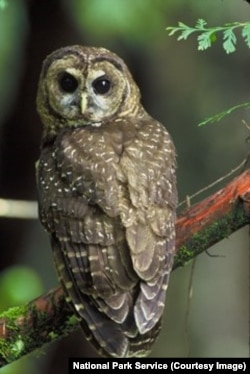This week on our national parks journey, we travel to the northwestern state of Oregon. Here, you will find a huge, deep lake. It waters seem impossibly blue. It is the deepest lake in America and one of the deepest lakes in the world. Its water is among the clearest and purest found on Earth.
Around the lake runs the wall of an extinct volcano. In the middle of the lake a small island rises over 230 meters above the surface.
Welcome to Crater Lake National Park.
The lake’s beauty inspires artists, photographers and nature lovers. That beauty was born from the violent burst of Mount Mazama about 7,700 ago. Hot liquid -- called magma -- rose from deep under the mountain, causing it to collapse.
The powerful burst destroyed the surrounding area. Huge amounts of ash fell on the land. The burst also left an enormous, circular hole in the mountain’s center. Scientists call this a caldera.
Over the next hundreds of years, rain and snow filled the hole with water. Rainfall and snowfall are the lake’s only source of water. It has no connections to the rivers and streams around it. That is what keeps its waters so pure.
As water collected, plants began to grow in the area again and animals returned. Scientists say it took about 250 years for the lake to rise to its current level.
Crater Lake is 592 meters deep. It is one of the 10 deepest on Earth. But, its depth is not the only remarkable quality. People are awed by its water color and clarity.
Crater Lake is so clear that, on most days, you can see nearly 30 meters below the surface. The lake takes on its intense blue color because of the water’s clarity. Sunlight reaches deep into the water.
Crater Lake gets its name from geology. A crater is a large bowl-shaped area on top of a volcano. The crater that formed the lake sits within the larger caldera.
Human History
Native Americans were in the area even before the lake’s formation. Researchers have found artifacts buried under layers of ash and dust from the Mount Mazama's huge eruption.
Following the burst, Native Americans considered Crater Lake to be a holy place. Ancient Native American stories describe the eruption of Mount Mazama.
European explorers and settlers did not arrive in the area until the middle 1800s. In 1865, a hunter became one of the first non-Native Americans to reach the shores of Crater Lake.
In 1870, a boy in Kansas read a newspaper article about the strange lake in Oregon. The story about Crater Lake fascinated the young William Gladstone Steel. He promised himself he would one day see this lake.
In 1872, Steel’s family moved to Portland, Oregon, about 375 kilometers north of the lake. Thirteen years later, Steel honored his promise and visited Crater Lake. Its beauty moved him greatly. He began a 17-year fight to preserve the area as a public park.
Steel was a writer. He described one of his first visits to Crater Lake in 1886 in the “West Shore” magazine.
“Not a foot of the land about the lake has been touched or claimed. An overmastering conviction came to me that this wonderful spot must be saved, wild and beautiful, just as it was, for all future generations.”
His proposal of creating a national park did not please nearby sheep herders and miners.
But, his efforts succeeded anyway. On May 22, 1902 Crater Lake became the country’s fifth national park. It remains the only national park in Oregon. And William Gladstone Steel is called the “Father of Crater Lake.”
Visiting the Park
Crater Lake National Park covers 740 square kilometers. The lake itself makes up less than 10 percent of the park. It also includes surrounding mountains and thick forests. The trees shelter many kinds of animals, from black bears to elk to spotted owls.
About 480,000 people visit Crater Lake National Park each year. They explore by car, bicycle, or on foot.
Roads that encircle Crater Lake usually are open from July through October, depending on weather. They provide breathtaking displays of the lake’s unusual blue color as well as the thick forests around it.
Crater Lake National Park also has more than 140 kilometers of hiking trails. The Cleetwood Cove Trail drops more than 200 meters down to the edge of Crater Lake. It leads to a spot where swimming is permitted.
The water is extremely cold. Most swimmers cannot stay in for more than a few minutes. Crater Lake’s average water temperature is just three degrees Celsius. In summer, the lake’s surface warms to about 10 degrees Celsius.
Visitors can also ride a boat from the end of Cleetwood Cove Trail. Park rangers lead visitors on boat rides around the lake. Visitors can also take boats to Wizard Island. The piece of land sits in the western part of the lake.
Volcanic eruptions formed Wizard Island. It rises over 760 meters above the lake floor. However, most of the island, about 500 meters, is underwater.
At Wizard Island, visitors can hike, swim and fish. It is also a wonderful place to relax and enjoy nature.
But, such extraordinary places can be found all over the park. Discovering one’s own is part of the magic to experience at Crater Lake National Park.
I'm Ashley Thompson.
And I'm Caty Weaver.
________________________________________________________________
Words in This Story
extinct - adj. no longer active
enormous - adj. very great in size or amount
remarkable - adj. unusual or surprising : likely to be noticed
awe - v. to have a strong feeling of wonder or surprise
artifact - n. a simple object (such as a tool or weapon) that was made by people in the past
fascinate - v. to cause (someone) to be very interested in something or someone.















